Proteomics is the application of rapidly evolving high-throughput technologies that enable analysis of proteins on a large scale. Recent advances in instrumentation have allowed detection, identification, and quantification of proteins with unparalleled precision and reproducibility, and this, in combination with novel bioinformatics tools, has helped to move proteomics from the simple cataloging of expressed proteins toward discovery of operating mechanisms in the biological systems. Proteomics holds great promise for advancing the understanding of viral pathogenesis, immunity, and the dynamics of virus–host protein interactions. Nevertheless, only a small number of proteomic studies have been done on animal viruses and avian herpesviruses in particular. This review summarizes the basic concepts and technologies used in proteomics and highlights the most successful applications of different proteomic approaches that resulted in identification of new virus–host protein interactions, mechanisms of genetic resistance and susceptibility to Marek's disease in chickens, and profiling and analysis of proteomes of Gallid herpesvirus 2 (GaHV-2), GaHV-3, and Meleagrid herpesvirus 1 infected or transformed cells. This review also discusses current limitations and potential future applications of proteomic methods in avian herpesvirus research.
Estudio Recapitulativo—Proteómica aplicada a los herpesvirus aviares.
La proteómica es la aplicación de tecnologías de rápida evolución, con alto rendimiento que permiten el análisis de proteínas a gran escala. Los avances recientes en instrumentación han permitido la detección, identificación y cuantificación de proteínas con precisión y reproducibilidad sin precedentes, esto en combinación con nuevas herramientas bioinformáticas, lo que ha ayudado a la evolución de la proteómica, de la simple catalogación de las proteínas expresadas, hacia el descubrimiento de los mecanismos operativos en los sistemas biológicos. La proteómica promete el avance de la comprensión de la patogénesis viral, la inmunidad, y la dinámica de las interacciones entre los virus y las proteínas del huésped. Sin embargo, sólo un pequeño número de estudios de proteómica se han hecho en los virus animales y en los herpesvirus aviares en particular. Esta revisión resume los conceptos básicos y las tecnologías utilizadas en la proteómica y se resaltan las aplicaciones más exitosas de diferentes técnicas de proteómica que dieron lugar a la identificación de nuevas interacciones entre los virus y las proteínas del huésped, los mecanismos de resistencia genética y la susceptibilidad a la enfermedad de Marek en pollos, así como el desarrollo de perfiles y análisis de proteomas de células infectadas o transformadas por el herpesvirus de las gallinas 2 (GaHV-2), por el GaHV-3, o por el herpesvirus 1 de los pavos. Esta revisión también aborda las limitaciones actuales y las posibles aplicaciones futuras de los métodos de proteómica en la investigación de los herpesvirus aviares.





